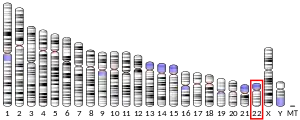RASD2
GTP-binding protein Rhes is a protein that in humans is encoded by the RASD2 gene.[5][6][7][8]
This gene encodes a Ras-related protein that is produced largely in the striatum. The product of this gene binds to GTP and possesses intrinsic GTPase activity. The gene belongs to the Ras superfamily of small GTPases. The exact function of this gene is unknown, but most striatum-specific mRNAs characterized to date encode components of signal transduction cascades.[8]
References
- GRCh38: Ensembl release 89: ENSG00000100302 - Ensembl, May 2017
- GRCm38: Ensembl release 89: ENSMUSG00000034472 - Ensembl, May 2017
- "Human PubMed Reference:". National Center for Biotechnology Information, U.S. National Library of Medicine.
- "Mouse PubMed Reference:". National Center for Biotechnology Information, U.S. National Library of Medicine.
- St Croix B, Rago C, Velculescu V, Traverso G, Romans KE, Montgomery E, Lal A, Riggins GJ, Lengauer C, Vogelstein B, Kinzler KW (Aug 2000). "Genes expressed in human tumor endothelium". Science. 289 (5482): 1197–202. doi:10.1126/science.289.5482.1197. PMID 10947988.
- Falk JD, Vargiu P, Foye PE, Usui H, Perez J, Danielson PE, Lerner DL, Bernal J, Sutcliffe JG (Oct 1999). "Rhes: A striatal-specific Ras homolog related to Dexras1". J Neurosci Res. 57 (6): 782–8. doi:10.1002/(SICI)1097-4547(19990915)57:6<782::AID-JNR3>3.0.CO;2-9. PMID 10467249.
- Vargiu P, De Abajo R, Garcia-Ranea JA, Valencia A, Santisteban P, Crespo P, Bernal J (Jan 2004). "The small GTP-binding protein, Rhes, regulates signal transduction from G protein-coupled receptors". Oncogene. 23 (2): 559–68. doi:10.1038/sj.onc.1207161. PMID 14724584.
- "Entrez Gene: RASD2 RASD family, member 2".
Further reading
- Dunham I, Shimizu N, Roe BA, et al. (1999). "The DNA sequence of human chromosome 22". Nature. 402 (6761): 489–95. doi:10.1038/990031. PMID 10591208.
- Chan SL, Monks LK, Gao H, et al. (2002). "Identification of the monomeric G-protein, Rhes, as an efaroxan-regulated protein in the pancreatic β-cell". Br. J. Pharmacol. 136 (1): 31–6. doi:10.1038/sj.bjp.0704680. PMC 1762110. PMID 11976265.
- Strausberg RL, Feingold EA, Grouse LH, et al. (2003). "Generation and initial analysis of more than 15,000 full-length human and mouse cDNA sequences". Proc. Natl. Acad. Sci. U.S.A. 99 (26): 16899–903. doi:10.1073/pnas.242603899. PMC 139241. PMID 12477932.
- Collins JE, Wright CL, Edwards CA, et al. (2005). "A genome annotation-driven approach to cloning the human ORFeome". Genome Biol. 5 (10): R84. doi:10.1186/gb-2004-5-10-r84. PMC 545604. PMID 15461802.
- Gerhard DS, Wagner L, Feingold EA, et al. (2004). "The Status, Quality, and Expansion of the NIH Full-Length cDNA Project: The Mammalian Gene Collection (MGC)". Genome Res. 14 (10B): 2121–7. doi:10.1101/gr.2596504. PMC 528928. PMID 15489334.
- Barrios-Rodiles M, Brown KR, Ozdamar B, et al. (2005). "High-throughput mapping of a dynamic signaling network in mammalian cells". Science. 307 (5715): 1621–5. doi:10.1126/science.1105776. PMID 15761153.
- Taylor JP, Jackson DA, Morgan NG, Chan SL (2006). "Rhes expression in pancreatic beta-cells is regulated by efaroxan in a calcium-dependent process". Biochem. Biophys. Res. Commun. 349 (2): 809–15. doi:10.1016/j.bbrc.2006.08.102. PMID 16945334.
- Agretti P, De Marco G, Pinchera A, et al. (2007). "Ras homolog enriched in striatum inhibits the functional activity of wild type thyrotropin, follicle-stimulating hormone, luteinizing hormone receptors and activating thyrotropin receptor mutations by altering their expression in COS-7 cells". J. Endocrinol. Invest. 30 (4): 279–84. doi:10.1007/bf03346294. PMID 17556863.
This article is issued from Wikipedia. The text is licensed under Creative Commons - Attribution - Sharealike. Additional terms may apply for the media files.



